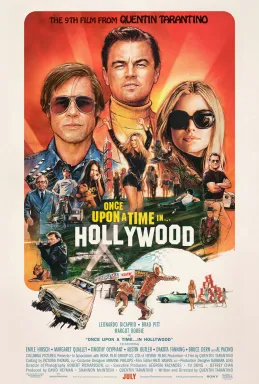Historical accuracy of Once Upon a Time in Hollywood

Historical accuracy of Once Upon a Time in Hollywood

Characters
Rick Dalton
Rick Dalton is a fictional lead character, though his career and personality are inspired by several real actors working in Hollywood during that era, such as Ty Hardin and Edd Byrnes.
Cliff Booth
Cliff Booth is a fictional character, serving as Rick's friend and stuntman. While potentially inspired by real stuntmen like Hal Needham and their relationships with actors, Cliff himself is not real.
Sharon Tate
The film portrays the real Sharon Tate respectfully, capturing her persona, but creates an alternate history by drastically altering the tragic events of her murder.
Jay Sebring
Jay Sebring was a real person accurately depicted as part of Tate's circle. However, like Tate, the film gives him a fictional fate different from his real tragic end.
Roman Polanski
Roman Polanski appears briefly as Tate's husband, which is historically accurate for the time period depicted.
Charles Manson
Manson is depicted briefly based on a real incident where he visited the Tate/Polanski residence looking for a previous tenant months before the murders.
More characters
Tex Watson
Tex Watson was a real Manson killer. The film shows him leading the attackers in the fictional climax, diverging significantly from the actual events and outcome.
Susan "Sadie" Atkins
Atkins was a real Manson follower involved in the murders. She appears as an attacker in the film's fictionalized alternate climax.
Patricia "Katie" Krenwinkel
Krenwinkel was a real participant in the Tate murders. She is shown as part of the attacking group in the film's fictional ending.
Linda "Flowerchild" Kasabian
Kasabian was the real driver for the killers who got cold feet. The film shows her in this role with similar hesitation during the fictional climax, altering the event but capturing her known role.
Lynette "Squeaky" Fromme
Squeaky Fromme was a real, prominent Manson follower. Her portrayal at Spahn Ranch aligns with historical accounts of her behavior and role within the Family.
George Spahn
George Spahn was the real owner of the ranch where the Manson Family lived. His portrayal as elderly, nearly blind, and his arrangement with the Family is accurate.
Bruce Lee
Bruce Lee was a real martial arts icon. The film's portrayal of him as arrogant was heavily criticized by his family as inaccurate, though the director defended it, making the accuracy disputed.
Steve McQueen
Steve McQueen is accurately depicted briefly as a major movie star connected to the social circle of Tate and Sebring.
Marvin Schwarz
Marvin Schwarz is a fictional character, an archetype of an agent/producer. While a real producer named Marvin Schwartz existed, Pacino's character and story arc are invented.
James Stacy
James Stacy was a real actor who starred in the Western series Lancer, accurately shown as the show Rick Dalton guest stars on.
Wayne Maunder
Wayne Maunder was a real actor who co-starred in Lancer, accurately portrayed in the context of filming that real TV show.
Trudi Fraser
Trudi Fraser is a fictional child actress created for the narrative to interact with Rick Dalton on the set of Lancer.
Francesca Capucci
Francesca Capucci is a fictional character introduced as Rick Dalton's wife following his work in Italy.
Story
The Manson Family's presence
The Manson Family was a real cult, and their presence in Hollywood in the late 1960s is a historical fact. The film accurately portrays their existence and their association with figures in the entertainment industry.
The events of the Tate murders
The film drastically deviates from the historical events of the Tate murders. In reality, Sharon Tate and her friends were brutally murdered by the Manson Family. The film presents an alternate, fictionalized outcome.
The portrayal of Bruce Lee
The film's portrayal of Bruce Lee has been criticized by some as being disrespectful and inaccurate. Some argue that it unfairly depicts him as arrogant and boastful, while others defend it as a fictionalized interpretation.
The fictionalized climax
The film's climax, in which the Manson Family members break into Rick Dalton's house and are confronted by him and Cliff Booth, is entirely fictional. It's a key part of the film's alternate history narrative and a significant departure from real events.
Setting
The atmosphere of 1960s Hollywood
The film excels in recreating the atmosphere of Hollywood in the late 1960s, including the music, fashion, and cultural trends. This is a well-researched and visually impressive aspect of the film.
The depiction of Spahn Ranch
Spahn Ranch was a real location where Charles Manson and his followers lived. The film's portrayal of the ranch and its association with the Manson Family is historically accurate.
The use of period-appropriate music
The film's soundtrack features music from the late 1960s, which contributes to the film's authentic atmosphere and helps to establish the historical setting.
The portrayal of the hippie movement
The film shows aspects of the hippie movement that were present in Hollywood at the time. The portrayal is more of a backdrop and doesn't delve deeply into the complexities of the movement itself.
